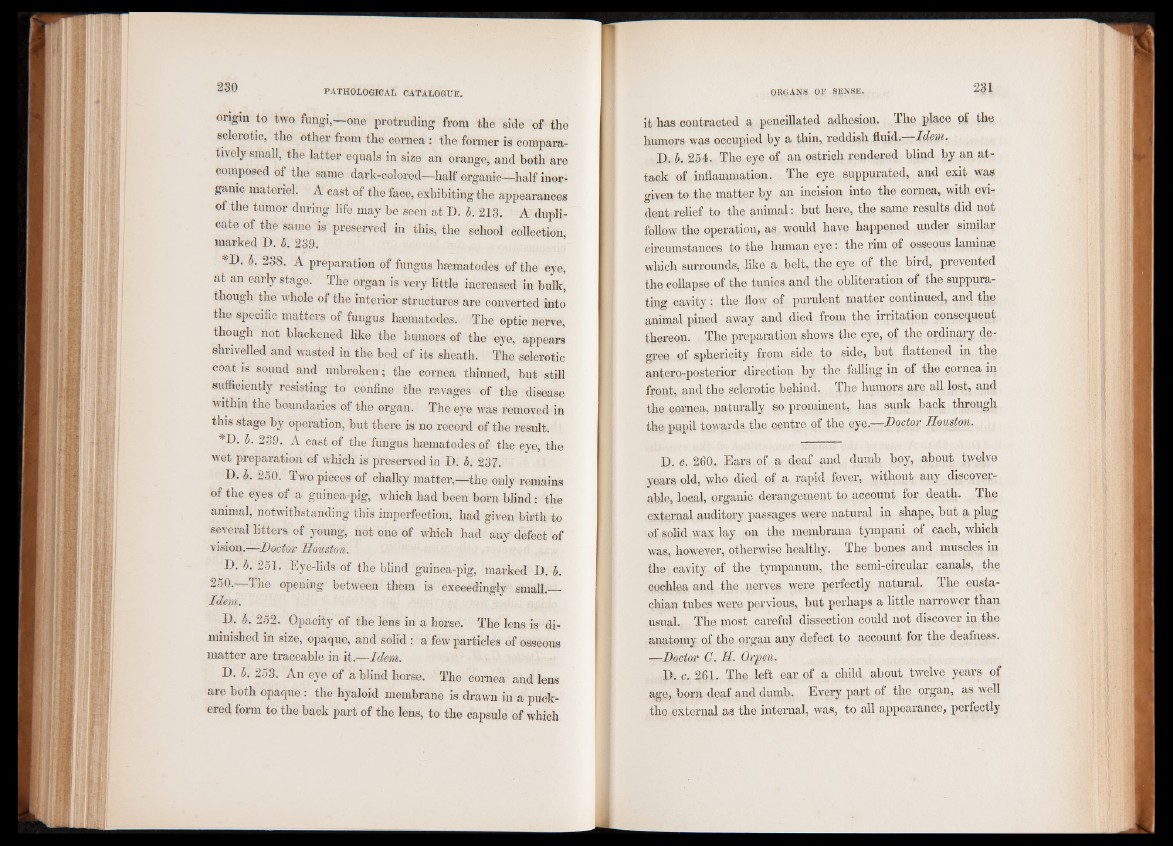
origin to two fungi,—one protruding from the side of the
sclerotic, the other from the cornea : the former is comparatively
small, the latter equals in size an orange, and both are
composed of the same dark-colored—half organic—half inorganic
materiel. A cast of the face, exhibiting the appearances
of the tumor during life may be seen at P. b. 213. A duplicate
of the same is preserved in this, the marked P. b. 239. school collection,
*D. b. 238. A preparation of fungus hiematodes of the eye,
at an early stage. The organ is very little increased in bulk,
though the whole of the interior structures are converted into
the specific matters of fungus heematodes. The optic nerve,
though not blackened like the humors of the eye, appears
shrivelled and wasted in the bed of its sheath. The sclerotic
coat is sound and unbroken; the cornea thinned, but still
sufficiently resisting to confine the, ravages of the disease
within the boundaries of the organ. The eye was removed in
this stage by operation, but there is no record of the result.
*D. b. 239. A cast of the fungus hsematodes of the eye, the
wet preparation of which is preserved in P. b. 237.
B. b. 250. Two pieces of chalky matter,-—the only remains
of the eyes of a guinea-pig, which had been born blind § the
animal, notwithstanding this imperfection, had given birth to
several litters of young, not one of which had any defect of
vision.—Doctor Houston.
D. b. 251. Eye-lids of the blind guinea-pig, marked P. b.
250. The opening between them is exceedingly small.—
Idem.
P. b. 252. Opacity of the lens in a horse. The lens is diminished
in size, opaque, and solid : a few particles of osseous
matter are traceable in it.—Idem.
P. b. 253. An eye of a blind horse. The cornea and lens
are both opaque : the hyaloid membrane is drawn in a puckered
form to the back part of the lens, to the capsule of which
it has contracted a pencillated adhesion. The place pf the
humors was occupied by a thin, reddish fluid. Idem.
P. b. 254. The eye of an ostrich rendered blind by an attack
of inflammation. The eye suppurated, and exit was
given to the matter by an incision into the cornea, with, evident
relief to the animal: but here, the same results did not
follow the operation, as would have happened under similar
circumstances to the human eye: the rim of osseous laminae
which surrounds, like a belt, the eye of the bird, prevented
the collapse of the tunics and the obliteration of the suppurating
cavity . the flow of purulent matter continued, and the
animal pined away and died from the irritation consequent
thereon. The preparation shows the eye, of the ordinary degree
of sphericity from side to side, but flattened in the
antero-posterior direction by the falling in of the cornea in
front, and the sclerotic behind. The humors are all lost, and
the cornea, naturally so prominent, has sunk back through
the pupil towards the centre of the eye.—Doctor Houston.
P. c. 260. Ears of a deaf and dumb boy, about twelve
years old, who died of a rapid fever, without any discoverable,
local, organic derangement to account for death. The
external auditory passages were natural in shape, but a plug
of solid wax lay on the membrana tympani of each, which
was, however, otherwise healthy. The bones and muscles in
the cavity of the tympanum, the semi-circular canals, the
cochlea and the nerves were perfectly natural. The eusta-
chian tubes were pervious, but perhaps a little narrower than
usual. The most careful dissection could not discover in the
anatomy of the organ any defect to account for the deafness.
—Doctor G. H. Or pen.
P. c. 261. The left ear of a child about twelve years of
age, born deaf and dumb. Every part of the organ, as well
the external as the internal, was, to all appearance, perfectly